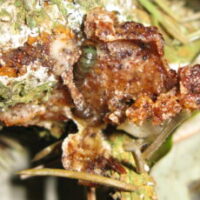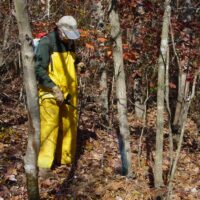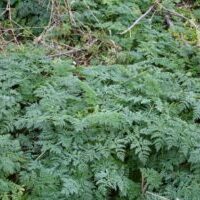 Purdue University - Extension - Forestry and Natural Resources
Purdue University - Extension - Forestry and Natural Resources
Got Nature? Blog
Purdue Landscape Report: Many areas around the Midwest continue to creep towards an increasing drought situation. Currently almost 80% of the Midwest is listed as being abnormally dry to exceptional drought. Current soil moisture data indicates that most of the Midwest is very dry. Going into the fall it’s very important to supply enough supplemental water (irrigation) to make up for the deficit prior to the landscape plants going dormant over the next six to eight weeks.
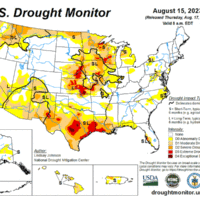
Figure 1. The progression of drought conditions have increased over the last two months in the Midwest. U.S. Drought Monitor.
The fall is a very important time to limit stressors on landscape plants. A stressed plant doesn’t produce as many secondary metabolites which aide in increased cold hardiness; so keeping your landscape plants irrigated during dry periods in late summer into fall is an important component of preparing plants for winter.
Remember some key steps concerning your landscape during extreme dry periods:
- Don’t wait until leaves begin dropping to start watering.
- Trees should receive the 5+5 rule.
- 5 gallons, plus 5 gallons per caliper inch.
- Ideally watering should occur in the early morning to prevent foliar diseases.
- Mulching to 3” can conserve moisture and reduce temperature in the upper root zone.
- Watering during dry conditions will help prevent future insect, disease, and other stress issues going into the fall and the following year. In fact, plants going into the winter that are stressed due to water deficiency will reduce the cold hardiness and therefore will be more likely to suffer cold injury and/or death.
- If a plant isn’t receiving enough water, the amount of nutrient uptake will not be sufficient and will experience deficiency from nutrients the following year.
To view this full article and other Purdue Landscape Report articles, please visit Purdue Landscape Report.
Subscribe and receive the newsletter: Purdue Landscape Report Newsletter.
Resources:
Trees in Times of Drought, Video, Purdue Agriculture
Drought Information, Indiana Department of Natural Resources
Drought? Don’t forget the trees!, The Education Store
Corn Belt Farmers’ Concerns About Drought and Heat-related Threats to Their Farm Operations, The Education Store
Safety Harvesting Quality Forage in a Drought, The Education Store
Planting Your Tree Part 1: Choosing Your Tree, Purdue Extension YouTube Channel
Tree Defect Identification, The Education Store
Tree Wound and Healing, Got Nature? Blog, Purdue Extension – Forestry and Natural Resources
Surface Root Syndrome, The Education Store
Planning the Tree Planting Operation, The Education Store
Tree Risk Management, The Education Store
ID That Tree, Purdue Extension-FNR YouTube playlist
Subscribe – Purdue Extension-FNR YouTube Channel
Kyle Daniel, Commercial Landscape and Nursery Crops Extension Specialist
Purdue Horticulture & Landscape Architecture
Purdue Landscape Report: Many trees are planted for their beautiful fall color, especially in locations where the climate provides reliable autumn weather. I have said this multiple times during extension talks and conversations with submitters to the Purdue Pest & Plant Diagnostic Lab (PPDL), but I seem to have not experienced a ‘normal’ fall since moving to Indiana with how erratic the weather has been from year to year. Depending on weather conditions, such as high heat and drought, colors may develop early or may be duller for specific varieties than expected.
However, individual trees that begin to show fall colors earlier than expected (August, September, even early October) may be shouting out a proverbial cry for help. Plants will often show yellow or red foliage coloration during periods of stress, so this may occur at any point during spring, summer, or fall. Individual trees may also show fall coloration earlier than others of their species in the same area. Now is the time to keep an eye out for this kind of early fall color as it can give you a heads-up on issues you can expect next year.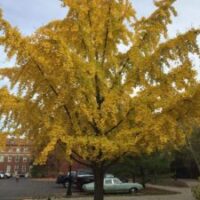
When examining a tree with early fall color, I would recommend checking the following:
- Is there a root flare?
Purdue Landscape Report: Deep Planting article- If not – tree could be planted too deep or the soil grade may have been changed
- Is there any obvious damage to the trunk, root flare, or surface roots?
- If so, there could internal decay that is not obvious and could be contributing to stress
- Are there any girdling roots?
Purdue Landscape Report: Stem Girdling Roots article- If present, they could be affecting the vascular system and strangling the tree
- Is the rootzone mulched?
- If not, the tree could be under stress from earlier drought, or weed and grass competition.
- If so, make sure it is not mounded against the trunk of the tree
- Does the soil appear compacted? Was there construction near the tree within the last 5 years?
- Compaction leads to issues with water, nutrient, and even oxygen availability to the roots and could lead to general decline
It is important to know the host species, but with the sheer volume of plant material available for sale in the nursery trade, it is even more important to know the cultivar that you are planting so you know what you might expect coming into the fall.
To view this full article and other Purdue Landscape Report articles, please visit Purdue Landscape Report.
Subscribe and receive the newsletter: Purdue Landscape Report Newsletter.
Resources:
Why Fall Color is Sometimes a Dud, Purdue Landscape Report
Forest Migration Plays a Role in Fall Foliage Colors, Purdue College of Agriculture News
U.S. Forest Service Fall Colors, Forest Service, U.S. Department of Agriculture
ID That Tree Fall Color: Sugar Maple, Purdue Extension – Forestry and Natural Resources YouTube Channel, ID That Tree Playlist
ID That Tree Fall Color Edition: Black Gum, Purdue Extension – FNR YouTube Channel, ID That Tree Playlist
Autumn Highlights Tour – South Campus, Purdue Arboretum Explorer
Why Leaves Change Color – the Physiological Basis, The Education Store, Purdue Extension resource center
Subscribe, Purdue Extension-Forestry and Natural Resources YouTube Channel
Planting Your Tree Part 1: Choosing Your Tree, Purdue Extension YouTube Channel
Summer Tree Care, Purdue Landscape Report
Tree Defect Identification, The Education Store
Tree Wound and Healing, Got Nature? Blog, Purdue Extension – Forestry and Natural Resources
Surface Root Syndrome, The Education Store
Shrubs and Woody Vines of Indiana and the Midwest, The Education Store
Ask an Expert: Tree Selection and Planting, Purdue Extension-Forestry & Natural Resources (FNR) YouTube playlist
ID That Tree, Purdue Extension-FNR YouTube playlist
John Bonkowski, Plant Disease Diagnostician
Departments of Botany & Plant Pathology
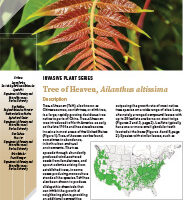 Tree-of-heaven (ToH), also known as Chinese sumac, varnish tree, or stink tree, is a large, rapidly growing deciduous tree native to parts of China. Tree-of-heaven was introduced to North America as early as the late 1700s and has since become invasive in most areas of the United States. Tree-of-heaven can be found, sometimes in abundance, in both urban and rural environments. The tree spreads through abundantly produced wind-scattered seeds from female trees, and sprout colonies arising from established trees, in some cases producing monoculture stands of the species. ToH has also been shown to produce allelopathic chemicals that can inhibit the growth of neighboring plants, providing an additional competitive advantage.
Tree-of-heaven (ToH), also known as Chinese sumac, varnish tree, or stink tree, is a large, rapidly growing deciduous tree native to parts of China. Tree-of-heaven was introduced to North America as early as the late 1700s and has since become invasive in most areas of the United States. Tree-of-heaven can be found, sometimes in abundance, in both urban and rural environments. The tree spreads through abundantly produced wind-scattered seeds from female trees, and sprout colonies arising from established trees, in some cases producing monoculture stands of the species. ToH has also been shown to produce allelopathic chemicals that can inhibit the growth of neighboring plants, providing an additional competitive advantage.
Tree-of-heaven is a serious threat as an invasive species in many habitats or untended areas. It can reach 80 feet or more, its growth rate outpaces most native tree species, and wind scatters seeds that female trees produce in abundance. Controlling ToH is a challenge. In this publication, Purdue University extension specialists and property managers explain herbicide options, application techniques and strategies to control and manage ToH.
To receive the free download visit the Purdue Extension’s resource center: The Education Store – Invasive Plant Series – Tree of Heaven, Ailanthus altissima.
View Forestry and Natural Resources (FNR) YouTube Video: ID That Tree: Invasive Tree of Heaven.
Resources:
Invasive Species, Playlist, Purdue Extension – FNR YouTube Channel
Report Invasive Species, Purdue Invasive Species
What are invasive species and why should I care?, Got Nature? Blog, Purdue Extension – Forestry and Natural Resources
Invasive plants: Impact on Environment and People, The Education Store, Purdue Extension’s resource center
A Woodland Management Moment, Playlist, Purdue Extension – Forestry and Natural Resources (FNR) Youtube Channel
Conservation Tree Planting: Steps to Success, Purdue Extension – FNR Youtube Channel
Forest Improvement Handbook, The Education Store
Tree Risk Management – The Education Store, Purdue Extension’s resource center
Investing in Indiana Woodlands, The Education Store
Woodland Invaders, Got Nature? Blog, Purdue Extension – FNR
Indiana Department of Natural Resources: Invasive Species
Invasive Plant Species Identification, Video, Purdue Extension – FNR Youtube Channel
Mile-a-minute Vine, The Education Store
Lenny Farlee, Extension Forester
Hardwood Tree Improvement & Regeneration Center (HTIRC) & Purdue University Department of Forestry and Natural Resources
Ron Rathfon, Regional Extension Forester, Southern Indiana Purdue Agriculture Center (SIPAC)
Purdue Forestry and Natural Resources
Purdue Landscape Report: A new invasive insect of concern has been identified in the state of Georgia. In August of 2023, Georgia’s Department of Agriculture, along with the USDA, confirmed the presence of the yellow-legged hornet, Vespa velutina, outside of the city of Savannah. To date, this is the only confirmed identification of this insect in the United States; it has already established in Europe, the Middle East, and parts of Asia outside of its native range. V. velutina is a native of the subtropical and tropical regions of southeast Asia, and it is not yet clear how it arrived in North America. Much like the northern giant hornet, previously known as the Asian giant hornet or ‘murder hornet’, this insect will attack honeybee hives in search of food and represents a potential danger to the beekeeping industry.
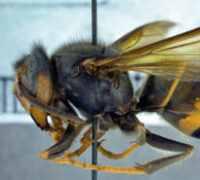
Figure 1. Yellow-Leg Hornet. Image Credit: Allan Smith-Pardo, Invasive Hornets, USDA APHIS PPQ, Bugwood.org
Yellow-legged hornets are predators and will regularly attack honeybees to provide food for their young, though it is possible they could attack other, similar species. Since honeybees concentrate their numbers in hives with a lot of in-and-out traffic, they provide an excellent opportunity for the hornets to hunt and provide food for their young. The hornets are effectively ambush predators, waiting in front of hive entrances and capturing workers with their legs as they leave the hive. The hornets then dismember the bees, returning to their young with only the thorax, which contains the largest amount of protein. However, it is believed that yellow-legged hornets only represent a lethal threat to weaker hives that are already experiencing problems; it is also too early to tell how already-existing honeybee issues, such as mite and disease issues, will interact with the presence of this insect.
The yellow-legged hornet, much like other members of Order Hymenoptera, is a social insect. They create oval or egg-shaped nests in trees that can house as many as 6,000 individuals. Colonies are composed of a foundress and her young, who become the workers within the colony. Female hornets will overwinter within tree hollows, leaf litter, or other environmentally stable locations, and once spring arrives, they start their own colony and give birth to new workers who care for young and hunt.
As with any new invasive species, it is critical to successful identify it and differentiate it from other species of wasps and hornets that we experience in the Midwest. At a glance, the yellow-legged hornet is barely discernable from European hornets, yellowjackets, and similar insects; they possess aerodynamic shapes with heavy yellow and black color patterns like many of their cousins. The most easily identified trait is their namesake: the legs of this insect tend to be black closer to the body, with the lower half of the leg bright yellow. The segments of the abdomen follow a similar pattern, with those segments closer to the center of the body being dominated by black, steadily becoming more yellow as you reach the tip of the abdomen. The yellow-legged hornet is also approximately an inch in length, with reproductive individuals sometimes reaching an inch and a half.
While remaining observant will be critical to reporting any invasive species, there are a few things to keep in mind about the yellow-legged hornet. This insect has only been found in one location in Georgia; no other states have any sightings or confirmed reports of this insect. There is also no evidence the insect has established a population in Georgia, there is only one confirmed sighting. The best course of action for now is to be vigilant and report any potential sightings by calling 1-866-NOEXOTIC, or you can contact our local Purdue Extension educator for assistance.
To view this full article and other Purdue Landscape Report articles, please visit Purdue Landscape Report.
Subscribe and receive the newsletter: Purdue Landscape Report Newsletter.
Resources:
Invasive Species, Playlist, Purdue Extension – FNR YouTube Channel
Report Invasive Species, Purdue Invasive Species
What are invasive species and why should I care?, Got Nature? Blog, Purdue Extension – Forestry and Natural Resources
Pest Management, The Education Store
Protecting Pollinators: Why Should We Care About Pollinators?, The Education Store, Purdue Extension resource center
Ask The Expert: What’s Buzzing or Not Buzzing About Pollinators , Purdue Extension – Forestry & Natural Resources (FNR) YouTube Channel
Purdue Pollinator Protection publication series, Purdue Extension Entomology
Subscribe Purdue Extension-Forestry and Natural Resources YouTube Channel
Bob Bruner, Exotic Forest Pest Educator
Purdue Entomology
Tom Creswell, Plant & Pest Diagnostic Laboratory Director
Purdue Botany and Plant Pathology
Cliff Sadof, Professor, Ornamental, Pest Management
Purdue Entomology Extension Coordinator
Purdue Landscape Report: Trees stressed by prolonged drought are more subject to attack by boring insects. This article provides tips and a video link on how to manage pines for borers.
Record breaking heat and sporadic rainfall during July of 2023 took their toll on landscape trees. Cone bearing evergreens, like white pines, are especially susceptible to drought and flooding. These environmental stresses reduce the ability of trees to defend themselves against boring insects. To make matters even worse, insect borers use their keen sense of smell to guide them to these stressed trees. Trees often take several years to recover from drought. Monitoring trees for early signs of decline is critical to a successful management program.
Early intervention can help you keep infested trees from becoming a breeding ground for borers that can destroy an entire planting. Trees that are more than half dead, or those whose needles are mostly yellow are usually too damaged to save. Removing these trees in late fall and winter removes the reproducing borers from the landscape before borers they can emerge to attack healthy trees. As an extra protective measure, insecticides can be applied on to the trunk to kill boring insects chewing into or out of the trees. Apparently healthy trees located near borer-infested trees can also benefit from a soil applied insecticides, like imidacloprid or dinotefuran applied in fall and early spring.
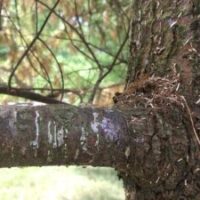
Figure 2. Fine powdery sawdust left by bark beetles and fine shavings of sawyer beetles are signs that a tree may already be too damaged to save.
Zimmerman pine moth (ZPM)commonly attacks pine trees in late July. Adult female moths lay eggs at the junction of tree branches and the trunk and winters in cracks and crevices. In early spring, when forsythia bloom, larvae bore inside the trunk and can girdle and kill branches and trees leaders. These are the two times of year that this borer is most susceptible to insecticides. Note soil applied imidacloprid is not particularly effective against ZPM. Spruces and most pines are susceptible to this borer.
To view this full article and other Purdue Landscape Report articles, please visit Purdue Landscape Report.
Subscribe and receive the newsletter: Purdue Landscape Report Newsletter.
Resources:
Borers of Pines and Other Needle Bearing Evergreens in Landscapes, The Education Store
Normal Needle Drop: Even Healthy Evergreens are not Evergreen, Purdue Landscape Report
White Pine Decline in Indiana
Tree Defect Identification, The Education Store
Tree wounds and healing, Got Nature? Blog
Tree Risk Management, The Education Store
Why Is My Tree Dying?, The Education Store
Managing the Zimmerman Pine Moth, The Education Store
The Woody Plant Seed Manual, U.S. Forest Service
Native Trees of the Midwest, The Education Store
Investing in Indiana Woodlands, The Education Store
Forest Improvement Handbook, The Education Store
Find an Arborist, International Society of Arboriculture
Subscribe Purdue Extension-Forestry and Natural Resources YouTube Channel
Cliff Sadof, Professor, Ornamental, Pest Management
Purdue Entomology Extension Coordinator
Purdue Landscape Report: Despite the sublime name, tree-of-heaven, Ailanthus altissima, is a particularly bad actor when it comes to trees encountered in the Midwest. This native of Asia was introduced to North America more than 150 years ago and has since become a widespread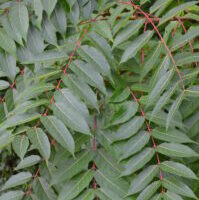 invasive pest. Rapid growth, extremely high seed production (hundreds of thousands from a mature female tree), and root sprouting that can turn one tree into dozens makes this a formidable competitor with our native plants. Tree-of-Heaven can sprout and grow almost anywhere, including cracks in streets and sidewalks or building foundations, resulting in infrastructure damage and increased costs of maintenance. It is also the preferred host for a new and destructive invasive insect pest, the spotted lantern fly.
invasive pest. Rapid growth, extremely high seed production (hundreds of thousands from a mature female tree), and root sprouting that can turn one tree into dozens makes this a formidable competitor with our native plants. Tree-of-Heaven can sprout and grow almost anywhere, including cracks in streets and sidewalks or building foundations, resulting in infrastructure damage and increased costs of maintenance. It is also the preferred host for a new and destructive invasive insect pest, the spotted lantern fly.
Reducing tree-of-heaven numbers on the landscape is a worthy goal, but can be a difficult task. Seed is windblown and can disperse for hundreds of yards or further, producing new populations. Tree-of-heaven will produce dozens of root sprouts if the stem is cut or girdled, even when herbicides are applied to the cuts. Both seedlings and root sprouts can grow rapidly, outpacing the native trees. However, there are effective control methods and even a potential biological control agent, a native wilt fungus, on the horizon. If you have tree-of-heaven or know of those who do, here are some methods to control this invasive tree.
Young seedlings and sprouts may be controlled with foliar applications of herbicides containing glyphosate during the summer growing season. Apply the herbicide and water mixture according to label directions, covering the entire leaf area. Pulling seedlings is an option, but any root fragments left in the soil may produce new sprouts.
Larger tree-of-heaven too tall for foliar spray may be controlled with a couple of other techniques. The basal bark technique applies an herbicide and oil mixture to the lower 15-18 inches of the stem of the tree. The oil carries the herbicide into the tree stem and kills the tree while also limiting the amount of root sprouting. This method is recommended for stems up to 6 inches in diameter, but larger stems have been controlled effectively with this approach. The best seasons for application are summer to winter, but avoid days where temperature is over 85 degrees F as the herbicide and oil mix can volatilize and damage non-target plants. Also discontinue applications if stems are wet or when snow cover is present. Recommended herbicides are the triclopyr ester herbicides and a commercially available basal oil mixed in a ratio of 20% herbicide and 80% oil.
Trees three or more inches in diameter may also be controlled using the “hack and squirt” method, also referred to as the injection method in some cases. A narrow cutting tool like a shingle hatchet is used to make 45 degree angled cuts through the bark of the tree around the circumference, with equal-sized uncut spaces between the cuts. Herbicides like glyphosate or triclopyr amine formulations are applied as directed on the label into the pockets created by the cuts. This treatment results in very few root sprouts as compared to cutting down or girdling the tree. The number of cuts should approximately equal the diameter of the tree in inches, and be sure to leave the uncut spaces between the cuts.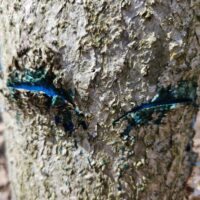
If the tree stems need to come down for safety or other reasons, apply the basal bark or hack and squirt treatments and wait approximately 30 days before cutting down the stem. This should allow time for the herbicide to impact the root system and limit the amount of root sprouting.
Work safely for yourself and the environment by reading and following the herbicide label, wearing the required personal protective gear, and working carefully with cutting tools.
To view this full article and other Purdue Landscape Report articles, please visit Purdue Landscape Report.
Subscribe and receive the newsletter: Purdue Landscape Report Newsletter.
Resources:
ID That Tree: Invasive Tree of Heaven, Purdue Extension – Forestry and Natural Resource (FNR) YouTube Channel
Control & Management — State of Indiana Cooperative Invasives Management (sicim.info)
Invasive Plant Control Database (wisc.edu)
Invasive Species, Playlist, Purdue Extension – FNR YouTube Channel
Report Invasive Species, Purdue Invasive Species
A Woodland Management Moment, Playlist, Purdue Extension – FNR Youtube Channel
Conservation Tree Planting: Steps to Success, Purdue Extension – FNR Youtube Channel
Forest Improvement Handbook, The Education Store
Tree Risk Management – The Education Store, Purdue Extension’s resource center
Investing in Indiana Woodlands, The Education Store
Woodland Invaders, Got Nature? Blog, Purdue Extension – FNR
Indiana Department of Natural Resources: Invasive Species
Invasive Plant Species Identification, Video, Purdue Extension – FNR Youtube Channel
Lenny Farlee, Sustaining Hardwood Extension Specialist
Purdue University Department of Forestry and Natural Resources
Starting in 2019, sassafras trees began wilting and dying in southern Indiana. It was originally thought that laurel wilt, a deadly disease in the southeastern U.S., had made its way to Indiana. However, neither the fungus responsible for causing laurel wilt nor its beetle vector were recovered from wilting trees at the time. A potentially novel fungus was recovered, as well as two i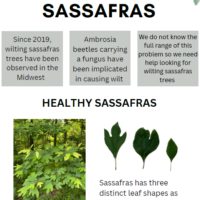 nvasive ambrosia beetle species. Invasive insects, particularly bark and ambrosia beetles are well-known carriers of devastating disease-causing fungi. Dutch elm disease is one of the most famous examples of a beetle-transmitted disease.
nvasive ambrosia beetle species. Invasive insects, particularly bark and ambrosia beetles are well-known carriers of devastating disease-causing fungi. Dutch elm disease is one of the most famous examples of a beetle-transmitted disease.
Sassafras trees are an important understory tree that aids in nutrient cycling and are important food sources for deer and rabbit populations in the winter months. They are also important to native butterfly populations like the Swallowtail butterfly, that uses sassafras as a host. At this time, we do not know what is killing our native sassafras trees or the range of impacted trees. This is a problem because if we do not know what is causing wilt or where trees are wilting, then we cannot work to identify ways to protect our native sassafras trees.
We need more help in identifying locations of wilting sassafras trees. We anticipate trees to start wilting towards the end of the summer, from late July through September. If you see any wilting or dying sassafras trees, please email sassafras.wilt@gmail.com to report it. You can also use the QR code on the bottom of the attached handout.
To learn more see the attached Sassafras Wilt Report Flyer.
Resources:
Report Invasive Species, Purdue Invasive Species
ID That Tree: Sassafras
ID That Tree: Sassafras Spring Bloom Edition
Morton Arboretum: Sassafras
Sassafras, Purdue Fort Wayne Native Trees of Indiana River Walk
ID That Tree Spring Bloom Editions, Got Nature Blog
Hardwood Lumber and Veneer Series: Sassafras, The Education Store
Purdue Arboretum Explorer
The Woody Plant Seed Manual, U.S. Forest Service
Native Trees of the Midwest, The Education Store
Shrubs and Woody Vines of Indiana and the Midwest, The Education Store
Investing in Indiana Woodlands, The Education Store
Forest Improvement Handbook, The Education Store
ID That Tree, Purdue Extension-Forestry & Natural Resources (FNR) YouTube playlist
Woodland Management Moment , Purdue Extension-FNR YouTube playlist
Olivia Bigham, Graduate Student
Purdue Forestry and Natural Resources & Hardwood Tree Improvement & Regeneration Center (HTIRC)
Matt Ginzel, Associate Professor
Purdue Forestry and Natural Resources & Department of Entomology
Purdue Landscape Report: I have lost count of the number of times I’ve witnessed people working with chainsaws in shorts, a tank top, and flip flops with maybe a pair of earbuds, and it makes me cringe every time. According to the CDC, over 36,000 chainsaw-related injuries a year are reported with annual medical costs of more than $350 million (Johnson, 2023). Wearing the proper personal protective equipment (PPE) can help prevent accidents and injuries (Fig. 1). PPE is there to protect you from head to toe and if you are investing in a chainsaw, it doesn’t take much more to invest in the proper PPE. Including a work shirt and pants, if you’re using a chainsaw you should wear protection for your head, eyes and ears, hands, legs, and feet, most of which can be found at your local hardware store or home center.
Protecting your head means using a helmet, not a baseball cap or bandanna. Depending on the type of work you’re doing there is a risk of being struck by wood or branches or if kickback occurs, sending the chainsaw back towards your head. Safety glasses will help keep sawdust and other debris out of your eyes and should be stamped with Z87.1, showing they conform to ANSI safety regulations. Normal glasses and sunglasses are not rated for being struck and can shatter, sending broken lenses into your eyes. Ear protection can be in the form of plugs or muffs and should be rated to reduce noise to appropriate levels when worn properly.
Most modern chainsaws have built-in anti vibration technology to reduce fatigue, but having a nice pair of work gloves will still help to protect your hands and grip. Gloves will help protect against debris and are also good to wear for chainsaw maintenance. Although not about PPE, another note on protecting your hands when operating a chainsaw includes the proper use of the chain brake. Injuries can occur on the right hand because operators will remove it from the back handle to activate the chain brake with the palm of their hand and miss it, putting their hand on the still moving chain. Injuries on either hand can happen when one handing a saw while using your other hand to brace or manage what you are cutting and losing control. The chain brake is designed to be engaged by popping your left wrist forward while maintaining a grip with both hands on the handles.
To protect your legs some form of chaps or chap pants are needed. Prices can range from around $40 for a pair of wrap-chaps that can be worn over your work pants up to around $400 for a high-end pair of chap pants that are a stand-alone work pant replacement. Whichever you choose to wear, the protection should be from the top of your thigh to the top of your foot and wrap around your calf. Care should be taken to keep them clean from gas and oil and if they are ever damaged by a chainsaw, chaps should be discarded and replaced. Once the protective material has been damaged the safety has been compromised. Chainsaw boots are also available to protect your lower legs and feet but are expensive and can be heavy. A sturdy work boot should be worn at the very least while staying alert to how close the chainsaw is coming to you. And please, no open-toed shoes.
Whatever the task, if you are going to do your own chainsaw work, then I implore you to wear your PPE from head to toe. I know it’s hot and can get uncomfortable, but all it takes is one mistake to send you to the ER. If you feel the job is beyond your capabilities you can always contact an ISA certified arborist at Find an Arborist through the treesaregood.org website.
To view this full article and other Purdue Landscape Report articles, please visit Purdue Landscape Report.
Subscribe and receive the newsletter: Purdue Landscape Report Newsletter.
Resources:
The Purdue Landscape Report
A Woodland Management Moment, Playlist, Purdue Extension – Forestry and Natural Resources (FNR) Youtube Channel
Conservation Tree Planting: Steps to Success, Purdue Extension – FNR Youtube Channel
Forest Improvement Handbook, The Education Store
Find an Arborist website, Trees are Good, International Society of Arboriculture (ISA)
Caring for storm-damaged trees/How to Acidify Soil in the Yard – In the Grow, Purdue Extension
Moist soil and rotten roots makes it easy for trees to come crashing down – Fox 59 News
Tree Risk Management – The Education Store, Purdue Extension’s resource center
Mechanical Damage to Trees: Mowing and Maintenance Equipment – The Education Store
Trees and Electric Lines – The Education Store
Tree Support Systems, The Education Store
Corrective Pruning for Deciduous Trees, The Education Store
Tree Installation: Process and Practices, The Education Store
Ben McCallister, Urban Forestry Specialist
Purdue Forestry & Natural Resources
Purdue Landscape Report: Poison hemlock was introduced to North America as a garden/ornamental plant. It is a native of Europe, and it is a member of the Apiaceae (parsley) family.
Purdue experts Bill Johnson and Marcelo Zimmer wrote about poison hemlock in a Purdue Pest & Crop newsletter.
They wrote that poison hemlock can be noticed very early in the spring every year, as it is typically one of the first weeds to green up, usually in late February to early March if temperatures are favorable. They said the largest threat of this weed is the toxicity of its alkaloids if ingested by livestock or humans, but it can also reduce the aesthetic value of landscapes and has been reported to creep into no-till corn and soybean fields as well.
Purdue Extension’s fact sheet on poison hemlock states that it can also be found along roads, streams, trails, ditches, forest edges, and waste areas.
The Purdue experts said that poison hemlock is a biennial weed that exists as a low-growing herb in the first year, and bolts to three to eight feet tall in the second year, when it produces flowers and seed. It is often not noticed until the bolting and reproductive stages of the second year. Poison hemlock is often confused with wild carrot, but can be distinguished by its lack of hairs and purple blotches that occur on the stems.
The experts pointed out that poison hemlock contains five alkaloids that are toxic to humans and livestock, and it can be lethal if ingested. They warn that the plant’s alkaloids may also be absorbed through the skin, so if you find yourself hand-pulling poison hemlock, it would be a good idea to wear gloves. All parts of the plants contain the toxic alkaloids with levels being variable throughout the year. Symptoms of toxicity include nervousness, trembling, and loss of coordination followed by depression, coma, and/or death. Initial symptoms will occur within a few hours of ingestion.
For history buffs, the Greek philosopher Socrates was sentenced to death by hemlock poisoning.
Cases of poisoning due to poison hemlock ingestion are rare as the plants emit a mousy odor that makes it undesirable and unpalatable to livestock and humans. Consumption and toxicity in animals usually occur in poorly managed or overgrazed pastures where animals are forced to graze poison hemlock because desirable forage is lacking.
To view this full article and other Purdue Landscape Report articles, please visit Purdue Landscape Report.
Subscribe and receive the newsletter: Purdue Landscape Report Newsletter.
Resources:
The Purdue Landscape Report
Purdue Pest & Crop Newsletter
Invasive Plant Species Fact Sheets: Poison Hemlock, The Education Store, Purdue Extension Resource Center
Poison Hemlock (Conium maculatum), United States Department of Agriculture (USDA)
Invasive plants: impact on environment and people, The Education Store, Purdue Extension’s resource center
Woodland Management Moment: Invasive Species Control Process, Video, Purdue Extension – Forestry and Natural Resources (FNR) YouTube Channel
Invasive Species, Playlist, Purdue Extension – FNR YouTube Channel
What are invasive species and why should I care?, Got Nature? Blog, Purdue Extension – FNR
Report Invasive, Purdue College of Agriculture – Entomology
John Woodmansee, Extension Educator, Whitely County
Purdue Extension
 MyDNR, Indiana’s Outdoor Newsletter: Did you know that Indiana’s waterways can be altered by the presence of aquatic invasive species? Non-native plants, animals, and organisms can disrupt bodies of water and ecosystems, threatening sport fisheries and other commercial resources.
MyDNR, Indiana’s Outdoor Newsletter: Did you know that Indiana’s waterways can be altered by the presence of aquatic invasive species? Non-native plants, animals, and organisms can disrupt bodies of water and ecosystems, threatening sport fisheries and other commercial resources.
If you’re wondering what you can do to help prevent the spread of aquatic invasive species, there are many easy steps that Hoosiers and out-of-state visitors can take to stop aquatic hitchhikers:
- Clean off any animals, plants, and mud from any angling or boating gear.
- Drain the water from watercrafts, bladder tanks, bilges, motors, livewells, and portable bait containers before leaving the water access area.
- Make sure everything air-dries for five days or longer or is dried with a towel.
- Dispose of any unwanted or unused bait, fish parts, and packing materials in the trash, rather than on the ground or in water. Remember, littering harms the environment.
DNR is counting on you to help protect Indiana’s waterways and species.
Newsletter can be found online: MyDNR Email Newsletter
For more information please visit DNR: Fish & Wildlife: Aquatic Invasive Species (AIS).
Resources:
Invasive Mussels, IN DNR Fish and Wildlife
Aquatic Invasive Species in the Great Lakes: The Quagga Mussel, Purdue Extension – Forestry & Natural Resources (FNR) Got Nature? Blog
Aquatic Invaders in the Marketplace, Illinois-Indiana Sea Grant (IISG)
Invasive Species, Playlist, Purdue Extension – FNR YouTube Channel
What are invasive species and why should I care?, Got Nature? Blog, Purdue Extension – Forestry and Natural Resources
Report Invasive Species, Purdue Invasive Species
The GLEDN Phone App – Great Lakes Early Detection Network
EDDMaps – Early Detection and Distribution Mapping System
Indiana Department of Natural Resources: Invasive Species
Indiana Invasive Species Council
Cooperative Invasive Species Management Area (CISMA)
Great Lakes Sea Grant Network (GLERL), NOAA – Great Lakes Environmental Research Laboratory
A Field Guide to Fish Invaders of the Great Lake Regions, Illinois-Indiana Sea Grant (IISG)
Purdue Researchers Get to the Bottom of Another Quagga Mussel Impact, Illinois-Indiana Sea Grant (IISG)
Invasive plants: Impact on Environment and People, The Education Store, Purdue Extension’s resource center
Protect Your Waters, U.S. Fish and Wildlife Service & U.S. Coast Guard
Nongame and Endangered Wildlife, Indiana Department of Natural Resources
Indiana Department of Natural Resources, Department of Fish & Wildlife
Recent Posts
- IN DNR Deer Updates – Epizootic Hemorrhagic Disease Detected in Several Areas in Indiana
Posted: October 16, 2024 in Alert, Disease, Forestry, How To, Wildlife, Woodlands - Flying Into July: Bird Banding Season Begins – MyDNR
Posted: August 6, 2024 in Alert, Forestry, Wildlife - 2024 Turkey Brood Count Wants your Observations – MyDNR
Posted: June 28, 2024 in Alert, Community Development, Wildlife - Spongy Moth in Spring Time – Purdue Landscape Report
Posted: June 3, 2024 in Alert, Forestry, Forests and Street Trees, How To, Invasive Insects, Urban Forestry - MyDNR – First positive case of chronic wasting disease in Indiana
Posted: April 29, 2024 in Alert, Disease, How To, Safety, Wildlife - Report Spotted Lanternfly – Purdue Landscape Report
Posted: April 10, 2024 in Alert, Forestry, Invasive Insects, Plants, Wildlife, Woodlands - Declining Pines of the White Variety – Purdue Landscape Report
Posted: in Alert, Disease, Forestry, Plants, Wildlife, Woodlands - Are you seeing nests of our state endangered swan? – Wild Bulletin
Posted: April 9, 2024 in Alert, Forestry, How To, Wildlife - 2024-25 Fishing Guide now available – Wild Bulletin
Posted: April 4, 2024 in Alert, Aquaculture/Fish, Aquatic/Aquaculture Resources, How To, Ponds, Wildlife - Look Out for Invasive Carp in Your Bait Bucket – Wild Bulletin
Posted: March 31, 2024 in Alert, Aquaculture/Fish, Aquatic/Aquaculture Resources, Invasive Animal Species, Wildlife
Archives
Categories
- Alert
- Aquaculture/Fish
- Aquatic/Aquaculture Resources
- Ask the Expert
- Christmas Trees
- Community Development
- Disease
- Drought
- Forestry
- Forests and Street Trees
- Gardening
- Got Nature for Kids
- Great Lakes
- How To
- Invasive Animal Species
- Invasive Insects
- Invasive Plant Species
- Land Use
- Natural Resource Planning
- Nature of Teaching
- Plants
- Podcasts
- Ponds
- Publication
- Safety
- Spiders
- Timber Marketing
- Uncategorized
- Urban Forestry
- Webinar
- Wildlife
- Wood Products/Manufacturing
- Woodland Management Moment
- Woodlands

